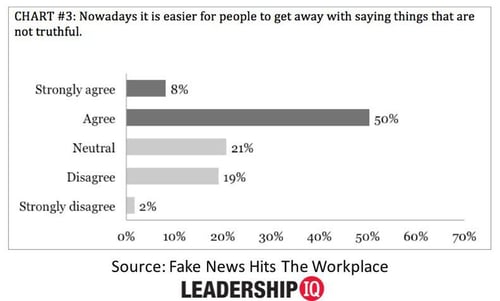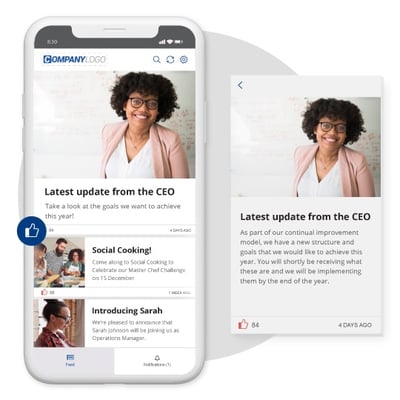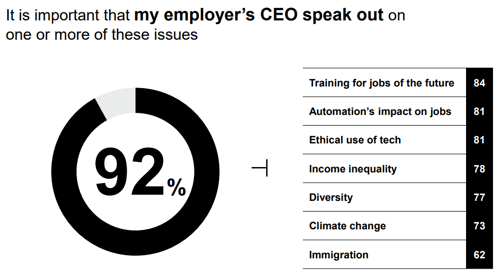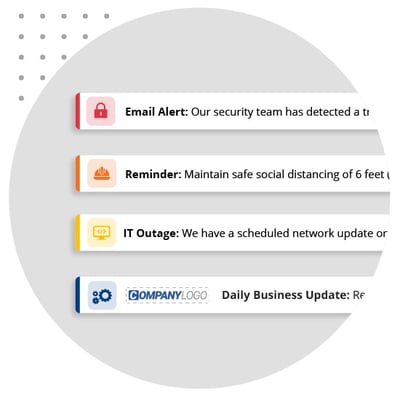
The end of the 20th century is heralded as the beginning of the Information Age. A time when the digital revolution took hold, computers appeared in every home and access to knowledge was greater than ever.
But today’s broad reach of media platforms and ready audience of followers risk a less desirable misinformation age, where conflicting perspectives on reality can misinform audiences.
COVID-19 and the vaccine rollout is just the latest, and most visible, example. Social media platforms have been forced to step up their fight against misinformation to address a lack of trust in vaccines. YouTube has removed over 800,000 videos related to dangerous or misleading coronavirus information since February 2020.
Misinformation is also rife in the workplace, and not just COVID misinformation. Any sort of change or workplace transformation can be a catalyst. And it seems that spreading misinformation has never been easier. In one business study, 58% believed it now easier for people to get away with saying things that are untruthful.
But why does misinformation spread so quickly, in what ways does it affect the business, and how can your internal communications prevent this?

Why does misinformation spread?
Terms like ‘fake news’ and ‘alternative facts’ are common and overused parts of our daily language – including at work. Workplace change, restructures, personnel issues and project setbacks are all rich areas to spread false information.
Rumors in the workplace may be unavoidable. But while it’s human nature for subjects like these to get employees talking, employers may be surprised by just how fast this chatter spreads. Results from a recent Twitter study suggest that false news spreads faster and more widely than the truth.
Some common reasons why misinformation spreads include:
- To fill the vacuum of information – if leadership teams haven’t been forthcoming with the information employees want, speculation and rumor will fill the vacuum
- To show resistance – employees in disagreement with a situation at work will demonstrate this through their comments
- To share anxiety or concerns – in times of change, employees express their feelings openly to seek the comfort of like-minded opinions
Some of the communication tools used in today’s workplaces foster this. Chat channels make it easy for employees to send messages that reach a large number of colleagues quickly. The nature of these channels also means that governance can be lower, often by design in order to promote open dialogue. But lack of oversight can result in misinformation being overlooked.
What are the effects of misinformation on business?
Misinformation is more than just workplace gossip or watercooler talk. It’s not just a spirited disagreement. It’s an active attempt to push false information or opinion as fact.
According to the 2020 Edelman Trust Barometer, 76% of people say they worry about false information or fake news being used as a weapon, an increase of 6% from 2018.
Businesses are also at risk from false information being presented as true, including:
- Stirring up negative sentiment – controversial statements can provoke negativity among a workforce, especially if employees are encouraged to ‘pick a side’
- Undermining trust in leadership – fostering speculation and untruths strengthens the belief that leadership are withholding information or being disingenuous
- Reducing business productivity – unsubstantiated, contradictory information causes a drain on productive time and a misalignment of employee efforts

5 ways to combat misinformation through internal communications
Imagine you’re launching a major new workplace initiative. It could be a departmental restructure, a return to the workplace after COVID-19, or a campaign to boost employee brand advocacy.
There’s a lot riding on the success of this initiative. A lot of people have invested a lot of time and effort. Misinformation spread by employees, however innocently, can undermine everything.
Facts are clouded by fiction. Staff have less belief in what they’re told. Employee engagement with and support of the initiative drops.
Internal communications are essential to combat the harmful spread of misinformation. This is the time the quality and regularity of your employee messaging must step up. As one expert on Forbes recommends, “Double-down on your multi-channel communication strategy for putting out correct information.”
Here are five ways you can leverage your business communication to address misinformation and align your workforce.
1. Executive backing
Endorsement from the top is essential in establishing the official company position. Executive communications not only provide clarity and certainty to employees, they also emphasize the importance of the subject at the most senior level.
Employees want to hear from leaders – especially on subjects which concern them, the company or the future direction. A report from 2020 shows that 92% of employees feel it’s important for their CEOs to speak out on significant workplace issues.
Combat misinformation by bringing your executives to the fore. Record a CEO video update and circulate this to all employees through a video alert. Authoritative messaging like this also serves to humanize executives, showing employees the real people behind the decisions.

Source: Edelman Trust Barometer 2020
2. Regular leadership messaging
Rumor mills are commonplace and inevitable. While they can provide a valuable release valve for employees, left unchecked they can take hold and harm workplace culture.
Rumors grow to fill the absence of information. Establishing a regular cadence of communication overcomes this. It builds transparency by delivering clear and credible information. Delivered regularly, employees know when to expect an update and therefore aren’t left feeling in the dark.
Ideally, these messages will come from the leadership team, providing a consistent stream of timely information. A dedicated digital newsletter is a useful way of collating all the latest news on a particular project or subject. Publishing a digest like this ensures messaging is focused on the subject, and allows it to be covered from different angles or different managers.
3. Reinforcement messaging
Repetition fosters understanding. It’s well known that people require multiple exposures to a message for them to take notice of it and understand it. The traditional Marketing ‘rule of seven’ propounds that it takes seven views of an advertisement for a consumer to want to buy the product.
Employee communications can also be approached like a marketing campaign. The use of repetition reinforces key messages by reaching employees multiple times such that they cannot be missed. It also minimizes the risk of misinformation, because repetition increases the likelihood that a statement will be judged as true.
In this way, simple communication channels such as company screensavers can become powerful messaging tools that achieve subconscious attitudinal change. In large centralized workplaces, such as hospitals or manufacturing facilities, digital signage screens can reach large numbers of workers who aren’t desk-based.

4. Dedicated online resource
Even with regular messaging, it’s possible for employees to forget what’s been communicated to them – especially if it concerns a long-term project or initiative. Creating and maintaining a central information resource provides employees a single source of truth, which reduces their uncertainty.
A dedicated intranet page or similar online platform is ideal for storing information in an accessible and searchable way. However, care must be taken that this is kept up to date, as trust in the resource will erode quickly if employees continue to see outdated material.
Direct employees to this resource every time an update is released or new information published. Employees will then become familiar with using it and will begin visiting it unprompted when they need something.

5. Two-way feedback loop
It’s unrealistic – and undesirable – to stifle employees’ voices when it comes to announcements or changes in the workplace. Attempting to do so will only provoke resentment and inspire a negative environment that breeds misinformation.
Establishing an outlet for employee questions and opinions is important in legitimizing their concerns and providing a controlled platform in which they can be addressed. A staff survey, collaboration tool or intranet chat forum may be suitable channels for this.
Managers must also proactively monitor internal social media posts to identify unvoiced issues – the things employees are dissatisfied about, but have not formally raised. Listening to employees, front-footing their concerns and communicating the outcomes back to them demonstrates employer support and a desire to improve together.
Misinformation can be a dangerous thing in the workplace. Once entrenched, false beliefs can be very hard to unwind. But with effective use of internal communications, managers and business leaders can deliver clear, authoritative messaging that informs employees and reduces the likelihood they’ll buy-into the next piece of idle watercooler talk.
SnapComms offers businesses a modern internal communications platform to inform and engage all employees. If you need to improve communications in the workplace, contact us – we can help you.



